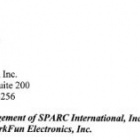JudasGutenberg
Member Since: September 19, 2006
Country: United States
-
i support ahmed, but that clock he's got isn't exactly homemade. it's clearly a digital clock he has removed from its chassis and placed inside a different case (one that looks like a small suitcase). the controller is clearly purpose-built for connecting to that particular four-digit LED display. i would have been more impressed had ahmed used an arduino or some similar microcontroller. that said, when i was his age, i used to take devices out of their cases and install them in boxes of my own making. that is also part of the fun of tinkering. I've made an annotated diagram of ahmed's clock here: (please note, the reference to an "explosive charge" is in jest): http://asecular.com/ran/1509/clock_big.jpg
-
worst lineup ever
-
you only have to type the parts of the captcha that have a change in background from white to black -- the easier to read half can take any string. this is because it is being used, as a side effect, to ocr difficult texts. of course, typing random crap for the ocr half will tend to screw that effort up.
-
confusion: if this device produces an analog output, wouldn't it be linearly proportional to temperature measured on any scale (celsius, fahrenheit, kelvin, etc.)? or does it actually produce a step pattern of voltages that precisely correspond to celsius degree divisions?
-
if this is the same as the optiboot bootloader i downloaded from here:
http://code.google.com/p/optiboot/
i have to say, it made things really easy on me. i could finally use the avr watchdog timer, which you will want to use if you have an embedded application that must work even when you are on vacation. -
it was fairly easy for me to make one of these so that it could either behave like an arduino (with the serial port hooked up like a max232 freeduino) or like a serial programmer. i have a big switch to flip between the modes. i added a zif socket in parallel with the socket it comes with and i use the non-zif socket to connect up wires when i'm doing simple arduino-style projects.
as others have said, the max232 is just sitting there. you have to hook it up yourself, even though it looks from the traces that such things should have been done for you. -
one problem when working with the receiver is that is data pins don't seem to be able to source enough power to drive a TTL input. i connected one to a speaker and it was loud as a freight train, but when i also connected it to a ttl input, it died away to nothing. buffered with a 74HCT04 CMOS inverting buffer, it could drive other circuits. the data is all garbled though, so obviously i have to something on the receiving end to clean it up.
-
This is the reason large corporations should be broken up. Once they reach a certain size, they want to march through Belgium. There is nothing more sociopathic than a large international corporation. In this case, the best solution is widespread ridicule. I'd get Steven Colbert involved.
-
The problem with heat energy is that it isn't very useful. Calculations have been done to show that the upper efficiency limit for converting it to mechanical or electrical energy (a less entropic, and thus more useful form) is something like 30%. And you get less efficiency the lower the temperature of your stored heat is. That's why you'd be better off superheating your water far beyond boiling inside a pressurized container.
Of course, if all you wanted to do with your hot water was make coffee, warm a bowl of soup, or take a shower, then there is no efficiency loss. Indeed, the most efficient way to collect solar energy intended for use as heat is to collect it directly as heat, as opposed to turning it into, say, electricity. For this reason, hydronic solar panels are much more adept at collecting solar energy that PV panels, although there's no sense in using the energy they collect for anything other than household heating needs. -
Here's an idea: make an arduino that's pin-for-pin compatible with the Diecimila but somehow shoehorns in a 40 pin Atmega644P - then we could load it up with the Sanguino bootloader and use in our conventional Arduino projects - but with 64 K RAM and more pins (accessible outside the Deciemila footprint). that would be totally awesome!
No public wish lists :(







